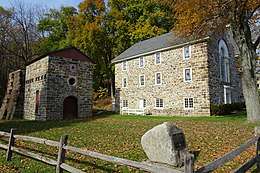Oxford Furnace, New Jersey
Oxford Furnace is a historic blast furnace on Washington Avenue, near the intersection with Belvidere Avenue, in Oxford, Oxford Township, Warren County, New Jersey. The furnace was built starting in 1741 and produced its first pig iron in 1743.[3] The first practical use in the United States of hot blast furnace technology took place here in 1834.[4] The furnace was added to the National Register of Historic Places on July 6, 1977 for its significance in industry during the 19th century.[5] It was later added as a contributing property to the Oxford Industrial Historic District on August 27, 1992.[6]
Oxford Furnace | |
 Oxford Furnace in 2015 | |
 Oxford Furnace  Oxford Furnace  Oxford Furnace | |
| Location | Belvidere and Washington Avenues Oxford, New Jersey |
|---|---|
| Coordinates | 40°48′14″N 74°59′52″W |
| Area | 0.6 acres (0.24 ha) |
| Part of | Oxford Industrial Historic District (ID91001471) |
| NRHP reference No. | 77000919[1] |
| NJRHP No. | 2775[2] |
| Significant dates | |
| Added to NRHP | July 6, 1977 |
| Designated CP | August 27, 1992 |
| Designated NJRHP | January 1, 1977 |
History
Oxford Furnace was the third charcoal furnace in colonial New Jersey and the first constructed at a site where iron ore was mined. The first two furnaces (Tinton Falls and Mount Holly) extracted ore from bogs in South Jersey, impure deposits called bog iron.[7]
The furnace was built starting in 1741 by Jonathan Robeson and Joseph Shippen, Jr., both of Philadelphia, and owned by the Shippen family who lived nearby in Shippen Manor. It produced its first pig iron on March 9, 1743.[3][5] Early products included fireplace firebacks embossed with the royal coat-of-arms of Great Britain during the reign of King George II.[3][8]
A grist mill was built adjacent to the furnace in 1813.[5] Later, c. 1909–1915, it was converted into the Oxford Methodist Church.[6]
In 1834, William Henry, manager of the furnace, achieved the first practical use in the United States of hot blast furnace technology, which increased production nearly 10%. This technology blew preheated air into the furnace, cutting production time. The next year, 1835, he introduced a hot blast oven placed on top of the stack, which further increased the temperature of the blast and increased production nearly 40%.[4][9]
Oxford Furnace operated the longest of any of the colonial furnaces, not being "blown out" until 1884.[7]
A restoration of the furnace occurred between 1997 and 2001.[7][10]
Gallery
 Oxford Furnace as it appeared in the late 1800s.
Oxford Furnace as it appeared in the late 1800s. The furnace, on the left, and the blowing house, on the right
The furnace, on the left, and the blowing house, on the right Oxford Furnace next to the Oxford Methodist Church
Oxford Furnace next to the Oxford Methodist Church Fireplace fireback cast at Oxford Furnace, 1745–58
Fireplace fireback cast at Oxford Furnace, 1745–58
Notable People
- George M. Robeson (1829–1897), Union general during the Civil War, and then Secretary of the Navy during the Ulysses S. Grant presidency[11]
References
- "National Register Information System". National Register of Historic Places. National Park Service. July 9, 2010.
- "New Jersey and National Registers of Historic Places - Warren County" (PDF). New Jersey Department of Environmental Protection - Historic Preservation Office. August 7, 2017. p. 7.
- Snell, James P.; Clayton, W.W. (1881). "The Iron Interests of Sussex and Warren Counties". History of Sussex and Warren Counties, New Jersey, with Illustrations and Biographical Sketches of its Prominent Men and Pioneers. Philadelphia: Everts & Peck. pp. 78–80. OCLC 14075041.
- Swank, James M. (1892). History of the Manufacture of Iron in All Ages, and Particularly in the United States from Colonial Times to 1891 (Second ed.). Philadelphia: American Iron and Steel Association. p. 453.
The first practical application of the hot-blast in this country was made at Oxford furnace, in New Jersey, in 1834, by William Henry, the manager.
- Karschner, Terry (January 1977). "National Register of Historic Nomination: Oxford Furnace". National Park Service. With accompanying 4 photos from 1977
- Bertland, Dennis (August 27, 1992). "NRHP Nomination: Oxford Industrial Historic District". National Park Service. With accompanying 104 photos from 1988
- Ptacek, Kathryn. "The Oxford Furnace Incident". New Jersey Skylands. Retrieved 30 November 2010.
- "Fireback". Morristown National Historical Park.
The embossed design of this fireback is the coat-of-arms of King George II.
- Lewis, W. David. "The Early History of the Lackawanna Iron and Coal Company: A Study in Technological Adaptation", Pennsylvania Magazine of History and Biography. October 1972.
- "Stabilization of the Oxford Furnace". Warren County Cultural & Heritage Commission.
- Sobel, Robert (1990). Biographical directory of the United States executive branch, 1774-1989. Internet Archive. New York : Greenwood Press.
External links
- Historic American Buildings Survey (HABS) No. NJ-236, "Oxford Furnace, Oxford, Warren County, NJ", 10 photos, 9 measured drawings, 5 data pages
